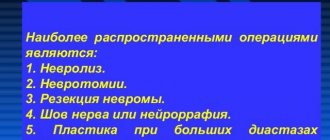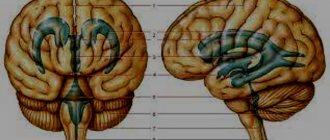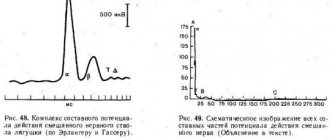The peripheral nervous system connects the central nervous system to the organs and limbs. Unlike the central nervous system, the peripheral nervous system is not protected by bones and has no physiological barrier separating it from the circulatory system. Therefore, the peripheral nervous system may be susceptible to mechanical damage and is more easily affected by toxins.
Diseases of peripheral nerves are neuropathies. They are characterized by damage to the axons and myelin sheath of the nerves. Diseases of the nerve trunks and plexuses rank second in prevalence among the population after diseases of the spinal roots (“radiculitis”). Therefore, issues of prevention, early diagnosis and subsequent treatment of neuropathies remain pressing problems.
Types
- Demyelinating. The conduction of excitation through neurons is disrupted. Occurs in cases of lead poisoning, diphtheria, polyradiculoneuropathy, and diabetic polyneuropathy. The patient's health is restored within a few weeks if treatment is started in a timely manner.
- Axonopathies. In this case, the damage concerns the axons (the processes of nerve cells) - these are severe disorders of nerve function. As a result, muscle atrophy occurs. The cause of these disorders is the abuse of alcohol and other toxic substances.
Neuropathies of mixed origin are most common. Full recovery and restoration of nerve function depends in part on the severity of the damage.
If the recovery process is absent 3 months after the onset of the disease, then the prognosis is most often unfavorable.
Types of neuropathy
- Mononeuropathies. One nerve or a specific part of the nerve plexus is injured. The causes of damage can be trauma, compression of any level of the nerve trunk. Also, mononeuropathies are observed in diabetes mellitus, atherosclerosis, vascular damage, etc. Hypothermia and herpetic infections are not the least important factors in the functioning of one nerve.
- Multifocal neuropathies are a syndrome of partial damage to individual nerve trunks or their complete damage. Such neuropathies occur slowly and sequentially (from several days to several years). Causes: arthritis, vasculitis and a number of systemic connective tissue diseases.
- Polyneuropathy. Lesions of peripheral nerves are multiple. Moreover, the process is widespread and symmetrical. It occurs both acutely and chronically. It happens that the spinal roots are also affected.
The causes of diseases of the peripheral nerve trunks and plexuses can be:
- injuries received
- decrease in normal immune system function
- hereditary diseases
- intoxication with various substances
- infections
- lack of vitamins
- habitual intoxication (drug addiction and alcoholism)
- allergies
Our neurosurgeons
- Barchenko Boris Yurievich - vertebrologist, neurosurgeon, traumatologist - orthopedist.
- Shaboldin Andrey Nikolaevich - spinal surgeon, vertebrologist, candidate of medical sciences, traumatologist - orthopedist.
Our doctors have extensive clinical experience in the field of surgical treatment of the spine and constantly improve and update their theoretical base by participating in Russian and international symposia and conferences dedicated to this field of medicine. They have thousands of successful operations and thanks from patients who have regained the joy of free movement and life without pain.
Symptoms
With neuropathies, symptoms can be different and depend on the affected areas. They cause a lot of discomfort to the patient:
- flaccid muscle paralysis
- pain in limbs
- change in skin sensitivity (there may be a contrast in sensations in one area of the skin compared to another)
- no sensation of pain and more
- amyotrophy
- speech disorder
- feeling of numbness in the face and limbs
- muscle weakness of the limbs
- impaired motor coordination
- dry skin
- focal blanching
- redness and bluish discoloration of the injured area
- Facial asymmetry may occur (if the facial nerves are damaged)
If you find yourself with at least one of the described symptoms, you should immediately seek help from a qualified neurologist.
Is neurosurgery dangerous?
The degree of risk of surgical intervention depends on the type and location of the operation. Today, thanks to innovative technologies, patients with spinal diseases are offered minimally invasive surgical methods that can reduce postoperative pain, reduce hospitalization time and quickly return to normal life.
In the case of some diseases, such as intervertebral hernia (in the lumbar or cervical region), as well as during surgery for decompression of the lumbar spinal canal, patients are offered treatment in a one-day hospital. Other pathologies requiring surgery may require longer hospitalization, from 3 to 7 days.
After the operation, the patient is monitored by medical staff throughout the entire rehabilitation period. Medical practice, based on the principles of evidence-based medicine and meeting the individual needs of patients, is the basis for the effectiveness of treatment in neurosurgery. Thanks to the use of new methods of minimally invasive surgery and accelerated recovery protocols, most patients can move independently in the evening or the next day after surgery. Depending on the operation, the patient can return to normal life within 3-6 weeks. In some cases, for a complete and rapid recovery, especially after “corrective” spinal surgery, the patient may be assigned a recovery program (7 to 14 days) at a rehabilitation center.
After a comprehensive comprehensive examination and treatment, the patient is given detailed recommendations on further preventive and supportive treatment, lifestyle, to prevent relapses of the disease and maximum social adaptation.
Treatment
In our clinic, traditional and alternative medicine methods are used to treat neuropathies. Complex treatment is selected only individually and depends entirely on the degree of damage to the nerve(s).
Initial treatment will be aimed at restoring the functions of the peripheral nerves, therefore, the cause will be eliminated.
An integrated approach is important in the treatment of neuropathies! Our specialists will take into account all the nuances of the damage and may prescribe:
- medications that improve metabolism, blood circulation and restoration processes in nervous tissue. Medicines can also be used in injection form, including intravenous drips in a cozy day hospital
- hormonal drugs (steroids) - in some cases
- therapeutic drug blockades
- certain types of physiotherapeutic treatment
- manual therapy (osteopathy)
- classic massage
2. Diagnosis of peripheral nerve injuries
For serious extremity injuries, initial examination may reveal peripheral nerve damage. When providing first aid, you need to pay close attention not only to the muscles and bones, but also try to identify or eliminate damage to the integrity of the nerves. Peripheral nerve injury may be indicated by:
- movement disorders;
- loss of sensation;
- weakening or loss of motor reflexes.
A thorough examination, palpation, analysis of the severity and depth of damage is carried out. Nerve fiber breaks may be visualized as whitish particles among the damaged tissue.
Visit our Neurosurgery page
Recommendations and prevention
The main prevention of most diseases of the nervous system is maintaining a healthy and active lifestyle, giving up bad habits, timely and adequate treatment of infectious and non-infectious diseases.
If any neurological symptoms occur, do not delay contacting a doctor. Early diagnosis and timely treatment will help prevent the development of complications, prolongation of treatment and the consequences of uncontrolled use of medications. The most complete program of preventive measures is drawn up by a neurologist for each individual patient.
Why is the nervous system needed?
The human nervous system performs several important functions at once: - receives information about the external world and the state of the body, - transmits information about the state of the whole body to the brain, - coordinates voluntary (conscious) movements of the body, - coordinates and regulates involuntary functions: breathing, heart rate , blood pressure and body temperature.
More movement
Movement is a natural human need. Find out how much you need to move for a good state of the nervous system.
FAQ
Three fingers on my right hand are numb and painful. What to do?
It is necessary to consult a neurologist to exclude carpal tunnel syndrome and treatment.
I had an attack of trigeminal neuralgia for a long time. Should I take something preventative to prevent another one?
It is imperative to see a neurologist. The doctor will select medications for you that need to be taken on a regular basis and prescribe preventive courses of injections (if necessary, drips in a day hospital) and tablet medications.
Severe burning pain appeared in the right half of the chest and some bubbles appeared. Which doctor should I see?
Similar manifestations, as you describe, can be observed with herpetic ganglioneuritis, the so-called. herpes zoster. This disease is treated by a neurologist.
After about 2 months, my legs began to go numb and weak. Why could this be?
Weakness and sensory disturbances in the limbs can be observed with polyneuropathies of various natures. For example, as a result of diabetes or intoxication. To establish the cause and select adequate therapy, you need to consult a neurologist. There may be a need for additional laboratory and instrumental examinations.
I developed weakness in my right hand after sleeping. Is it from the spine?
The cause of sudden weakness in the arm may also be diseases of the spine. However, a vascular cause or compression of the nerve trunk (nerve plexus) cannot be excluded. To find out the cause and prescribe treatment, you should consult a neurologist.
Can alcoholic neuropathy be cured?
Toxic and dysmetabolic polyneuropathies, incl. alcoholic diseases are most often chronic diseases. With adequate therapy, it is possible to achieve long-term and stable remission
3. Neurolysis of peripheral nerves of the limbs
Surgical treatment of nerve damage can be carried out at different times after injury: primary, delayed and late operations.
Neurolysis
is an effective technique for restoring damaged nerves of the limbs, allowing the limbs to return functionality and sensitivity.
In a number of situations, during neurolysis, a nerve is transposed
, that is, it is displaced or a fragment is transferred from other parts of the body for implantation at the site of the rupture.
The essence of neurolysis
– in isolating nerve fiber and eliminating factors that disrupt its conductivity. This is, first of all, compression due to scars or calluses. This kind of disruption of nerve conduction simultaneously causes loss of a number of functions of the limb and increased irritation of the nerve, manifested by pain.
Surgical manipulations for neurolysis require a significant tissue incision so that the surgeon can isolate the nerve from the surrounding tissue. Projection, non-projection, roundabout and angular access on bends is possible. Particular attention is paid to the preservation of the connection between muscle tissue and nerve fiber.
During the operation, damaged sections of the nerve can be removed, after which the ends are sutured or the fragments are transposed. The surgical technique here has a number of features; special suture materials and micro-instruments are used.
About our clinic Chistye Prudy metro station Medintercom page!
Treatment stories
Case No. 1
Patient Yu., 40 years old, noticed sudden facial asymmetry, lacrimation from the right eye and incomplete closure of the eyelids. I contacted a neurologist at the EXPERT Clinic. The patient was diagnosed with acute neuritis of the facial nerve and prescribed treatment and examination. The patient completed a course of intramuscular and intravenous drip injections in the day hospital of the EXPERT Clinic, courses of physical therapy and acupressure self-massage. Movements in the facial muscles have been completely restored. During the examination, the oncological nature of the disease was excluded, but its herpetic nature was revealed against the background of a secondary immunodeficiency state. After consulting an immunologist, patient Yu was prescribed a course of immunomodulatory therapy.
How is a neurosurgeon different from a neurologist?
Both a neurologist and a neurosurgeon are medical specialists who deal with disorders of the nervous system: the mechanisms of their development and manifestation (pathogenesis), identifying symptoms and direct treatment.
The main difference between them is that a neurologist deals with conservative therapeutic treatment of diseases, while a neurosurgeon deals with more serious cases that require surgical intervention.
Typically, a neurologist is the first to detect a disease, identifies it and prescribes therapeutic treatment himself, or sends him for a consultation with a neurosurgeon to choose the most optimal treatment option.
Neurosurgeons can treat patients either conservatively or surgically. But not in all cases the neurosurgeon will insist on surgical intervention. If it is possible to avoid it, as well as in the event of a possible risk for the patient, the choice will be conservative therapeutic treatment.
A patient may require both a neurologist and a neurosurgeon, or just one, depending on the condition being treated and its severity. In some cases, surgery may be necessary first, performed by a neurosurgeon, with long-term follow-up by a neurologist.









